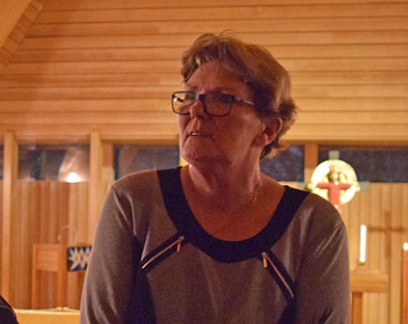The most human aspect of Annika Östberg’s story—the tragic death of her teenage son Sven in 1985—has frequently been forgotten despite the fact that it has been recounted in courtrooms, newspapers, and books. She was serving a life sentence in California at the time, and the terrible car accident that killed him not only devastated her on an emotional level but also started a downward spiral that she later acknowledged had left her vulnerable.

The son’s passing was more than just a private matter; it served as the quiet background for everything that transpired. Annika was already facing decades in prison for her involvement in two murders, including the murder of a police officer, when Sven passed away at the age of 15. In her autobiography, she detailed how the news of his passing overtook her like a tidal wave, tearing down the flimsy foundation of hope she had constructed.
Bio and Case Table
| Category | Information |
|---|---|
| Full Name | Annika Maria Östberg Deasy |
| Date of Birth | January 6, 1954 |
| Birthplace | Sweden |
| Occupation | Author, former restaurateur |
| Notable For | Conviction in California for involvement in two murders (1981) |
| Sentence | 25 years to life (1983), served 28 years before release in 2011 |
| Transfer | Returned to Sweden in 2009, released May 2, 2011 |
| Children | Son Sven (died 1985, age 15) |
| Autobiography | Published in 2011, revealed hidden struggles |
| Reference |
Within the California Institute for Women, she relapsed into heroin use between 1985 and 1989. She concealed it for decades out of concern that confessing to drug use would make it more difficult for her to be transferred to Sweden. Years later, she admitted that other prisoners offered her heroin as a temporary escape in an attempt to ease her grief. With a voice that was unusually clear, she explained that, despite her hatred of the relapse, it paradoxically saved her life during a storm of suffering that she might not have otherwise survived.
Grief outside of prison is not the same as grief inside. There are no family get-togethers, rituals, or places to grieve. There were no pictures of Sven on Annika’s walls, no memento to cling to. She acknowledged that she couldn’t bear to see his picture in a static state. She bore the burden of short-lived motherhood in that silence. Her entire experience in prison was shaped by this deeply isolating grief.
The way her story was viewed changed dramatically when she came clean about this loss and the relapse. She was once portrayed solely as a criminal, but she later revealed herself to be a complex, flawed mother dealing with the most trying situations. It proved to be incredibly successful in igniting a more in-depth social discussion about whether empathy is limited to the innocent or if it can also be extended to those who have committed grave crimes.
After 28 years in American custody, her eventual return to Sweden in 2009 was widely regarded as a diplomatic victory. Annika, however, felt both fear and relief. Her fate changed “in the blink of an eye, through a few strokes of the pen,” she explained, calling it surreal. It emphasized how politics, the media, and timing greatly influence justice, despite the fact that it is frequently presented as inflexible.
Another chapter began when she was released in May 2011; this time, she was not confined. Soon after, her autobiography was released, revealing the secrets she had long concealed. In her open letter, she admitted that she had lied about never using drugs while incarcerated and that she had been afraid of being caught during the years she spent advocating for her transfer. She acknowledged that she was afraid of media attention because she understood how American political will could be influenced by public opinion.
The way celebrity narratives develop in contemporary culture is especially comparable to this intersection of crime, grief, and media. In the same way that well-known people like Robert Downey Jr. recovered from addiction and scandal, Annika tried to reinvent herself—not as a celebrity, but as a survivor with a story that taught her hard lessons. Her book provided a means of atonement as well as confession, establishing her as a writer who uses her voice to give meaning to her experiences in addition to being a former prisoner.
Sven’s passing was still crucial to that change. Despite his brief 15-year life, his absence permeated every aspect of her story. His loss was the unhealed wound she carried into freedom because he served as a reminder of her former self. His narrative gave Annika a human face that no legal detail could. It was especially helpful in igniting more general conversations about trauma, coping strategies, and the fortitude needed to endure terrible loss.
Her experience serves as an example of the duality of judgment. Her story serves as an example of how a human being can endure extreme adversity, while others continue to refuse to distinguish between her crimes and her suffering. Her fortitude in the face of loss and imprisonment highlights how effectively survival instincts adjust, even under the most dire conditions.
She has opted for a peaceful life in the Swedish countryside in the years since her release. Even though it is far from courtrooms and prison gates, her past still haunts her. Although writing about Sven’s death has significantly improved as a healing tool, she acknowledges that she has not yet fully processed his passing. She now emphasizes that “there is always hope, no matter how dark things may appear” in her cautiously upbeat speech.
Because it touches on a universal human need—the need to find light in the dark and to maintain faith in the possibility of change—that statement strikes a chord with many people. Annika’s sorrow over Sven’s passing has never completely gone away; instead, it has been transformed into a tale of survival that highlights how brittle and extraordinarily adaptable the human spirit can be. In addition to crime and punishment, it also tells of motherhood, loss, and her continuous quest for atonement.
